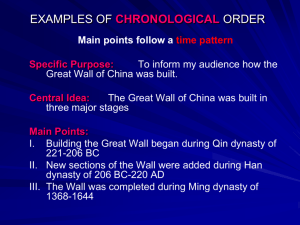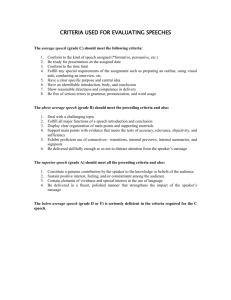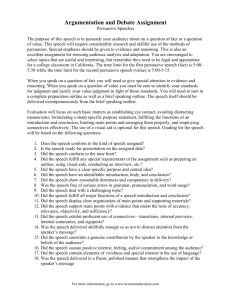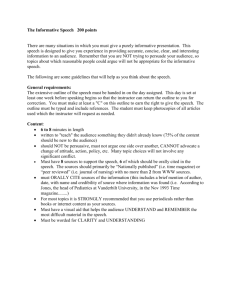Powerpoint - GEOCITIES.ws
advertisement
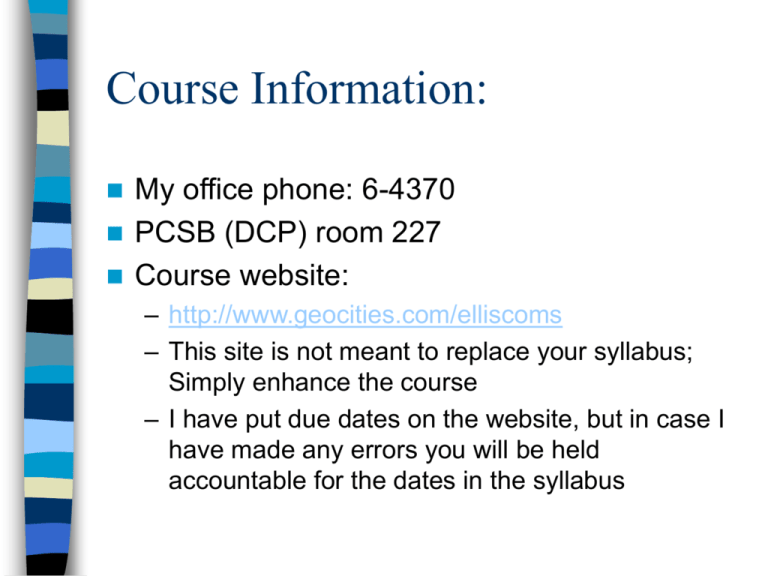
Course Information: My office phone: 6-4370 PCSB (DCP) room 227 Course website: – http://www.geocities.com/elliscoms – This site is not meant to replace your syllabus; Simply enhance the course – I have put due dates on the website, but in case I have made any errors you will be held accountable for the dates in the syllabus Chapter 8 Organizing the Body of the Speech Importance of Organization Perceptions of comprehension and trustworthiness Strategic organization: – Putting a speech together in a particular way to achieve a particular result with a particular audience – Importance of strategic organization • Audience can not “flip” between ideas • Establishment of relationships among ideas Main Points of the Speech Most speeches have 2-5 main points Main points flow logically from the specific purpose and central idea Style in which you choose to present these points is essential to communication 5 Strategic Order Forms for Organization of Main Points Chronological Spatial Causal Problem-solution Topical Chronological Order Specific purpose: to inform my audience of how the great wall of china was built Central idea: the great wall of china was built in three major stages. Main points: – Building the great wall began during the Chou dynasty in the fourth century BC – New sections of the great wall were added during the Ch’in, Han, and Sui dynasties from 221 BC to 618 BC – The great wall was completed during the Ming dynasty of 1368-1644 Spatial Order Specific purpose: to inform my audience about the design of the Eiffel tower Central idea: the Eiffel tower is divided into three sections Main points: – The lowest section of the tower contains the entrance, a gift shop and a restaurant – The middle section of the tower consists of stairs and elevators that lead to the top – The top section of the tower includes an observation deck with a spectacular view of Paris Causal Order Specific purpose: to persuade my audience that the use of aging airplanes by US airline companies is a serious problem Central idea: the use of aging planes by US airline companies threatens the safety of air travel Main points: – To meet the demand for air travel, airline companies are keeping more and more old planes in service. – If this trend continues, it will create serious problems for airline safety Problem-Solution Order Specific Purpose: To persuade my audience that the US should act now to protect its citizens against electronic invasions of their privacy Central Idea: The loss of personal privacy in our electronic society is a serious problem that requires decisive action Main Points: – The use of electronic data gathering by business and government poses a serious threat to personal privacy – The problem could be greatly reduced by federal privacy laws that impose strict controls on the collection of personal information by businesses and government agencies Topical Order Specific purpose: to inform my audience of the major kinds of fireworks Central idea: the major kinds of fireworks are skyrockets, roman candles, pinwheels and lances Main points: – Skyrockets explode high in the air, producing the most dramatic effects of all fireworks – Roman candles shoot out separate groups of sparks and colored flames with a series of booming noises – Pinwheels throw off the sparks and flames as they whirl on the end of a stick – Lances are thin, colorful fireworks used in ground displays Tips for Preparing Main Points Keep main points separate and independent of each other Consistent patterns for wording of main points Balance amount of time devoted to each point Supporting Materials Used to support the main assertions (points) 3 types of supporting materials – Examples – Statistics (see website) – Testimony (expert or your own) Supporting Materials (cont’d) Chapter 7 will cover these in more detail For our purposes now: – Organization is key – Relevance to your topic is necessary Connectives “A word or phrase that connects the ideas of a speech and indicates a relationship between them” 4 types of connectives: – Transitions – Internal previews – Internal summaries – Signposts Connectives are essential for listener understanding Chapter 9 Beginning and Ending the Speech The Importance of Introductions Catch phrases: – “A poor beginning may so detract or alienate listeners that the speaker can never fully recover” – “Getting on the right foot is vital to a speaker’s self-confidence” 4 Main Objectives for Every Introduction Get attention and interest Reveal the topic Establish credibility and goodwill Preview the body of the speech 7 Ways to Get Attention and Interest Relating the topic to the audience • UConn’s Poultry Science Club State the importance of your topic Startle the audience Arouse the curiosity of the audience Question the audience Begin with a quotation Tell a story 4 Main Introduction Objectives (Cont’d) Reveal the topic clearly Establish credibility and goodwill – Credibility – Goodwill Preview the body of the speech – Use a preview statement in the introduction to identify the main points – Preview statement comes at the end of the intro 5 Tips for Preparing the Introduction Keep the intro fairly brief Look out for information during your research that could contribute to an intro Be creative in devising your intro; experiment with two or three versions for most impact Do not worry about exact wording until your speech is complete Work out the introduction in detail The Conclusion Closing remarks are your last chance to make a point! Delivery is key (next week) 2 Goals of the Conclusion Signal the Ending – Crescendo Ending? – Dissolve Ending? Reinforce the Central Idea – Summarize the speech – End with a quotation – Make a dramatic statement – Refer to the Introduction 4 Tips for preparing the Conclusion Look out for potential concluding material during research process Conclude with a BANG not a whimper DO NOT be long winded Don’t leave anything to chance; practice thoroughly Chapter 5 Analyzing the Audience Audience Centeredness Keep the audience as the central consideration during all points of speech process (development and delivery) Learn about your audience for a pre-emptive strike in adaptation Identification: Process through which a speaker seeks to create a bond with the audience by emphasizing common ground Classmates ARE an Audience Use this class as a testing ground for your future The best speeches take into account the feelings, attitudes and perspectives of your classmates Treat this audience as any professional speaker would treat theirs Psychology of Audiences Speaker must make the audience choose to listen – Interference – Auditory perception is selective Egocentrism – Audience is concerned with themselves – “Get inside their experience” – Make your topic relevant to them Demographic Audience Analysis Age • Challenger? Columbia? Gender/Sexual Orientation • Topic Choice? Racial, ethnic or cultural background • Lott and Thurmond, 1948 campaign • Bubba and South Korea Religion • Episcopalians; W. against same-sex marriages Group memberships • NRA, UConn Student, Sports team, Greeks, etc. Situational Audience Analysis Size Physical setting Audience disposition toward the topic • Interested or Indifferent? • Knowledgeable? • Predetermined attitude? Audience disposition toward the speaker • response to message is Impacted by perceptions of trust Audience disposition toward the occasion • follow social norms Getting Information About the Audience Interviews Questionnaires (see page 115) – Three types of questions • Fixed-alternative • Scale questions • Open-ended questions Adapting to the Audience Two stages of adaptation: – Before the speech – During the speech Always keep in mind that good speakers are audience-centered
